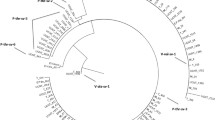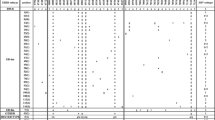Abstract
Epstein-Barr virus–related malignancies have been linked to variations in the sequences of EBV genes, notably EBNA1. Therefore, the purpose of this study was to examine the DBD/DD domain and USP7 binding domain sequences at the C-terminus of the EBNA1 gene in patients with chronic lymphocytic leukemia (CLL). This study included 40 CLL patients and 21 healthy volunteers. Using commercial kits, total DNA was extracted from buffy coat samples, and each sample was tested for the presence of the EBV genome. The C-terminus of EBNA1 was then amplified from positive samples, using nested PCR. Sanger sequencing was used to identify mutations in the PCR products, and the results were analyzed using MEGA11 software. The mean ages of CLL patients and healthy individuals were 61.07 ± 10.2 and 59.08 ± 10.3, respectively. In the EBNA-1 amplicons from CLL patients and healthy individuals, 38.5% and 16.7%, respectively, harbored mutations in the DBD/DD domain of the C-terminal region of the EBNA1 gene (P = 0.378). The mutation frequency at locus 97,320 was significantly higher in CLL patients than in healthy individuals (P = 0.039). Three EBV subtypes based on residue 487 were detected. The frequency of alanine, threonine, and valine in both groups was 88, 8, and 4 percent, respectively (P = 0.207). Moreover, all of the isolates from healthy donors had alanine at this position. The findings indicated that the presence of threonine or valine at residue 487 as well as a synonymous substitution at residue 553 in the C-terminal region of EBNA1 might be involved in the pathogenesis of EBV in CLL patients.

Similar content being viewed by others
Data Availability
The datasets analyzed in the current study are available from the corresponding author on reasonable request.
References
Kocarnik JM, Compton K, Dean FE, Fu W, Gaw BL, Harvey JD, Henrikson HJ, Lu D, Pennini A, Xu R (2022) Cancer incidence, mortality, years of life lost, years lived with disability, and disability-adjusted life years for 29 cancer groups from 2010 to 2019: a systematic analysis for the Global Burden of Disease Study 2019. JAMA Oncol 8:420–444
Chiorazzi N, Chen S-S, Rai KR (2021) Chronic lymphocytic leukemia. Cold Spring Harb Perspect Med 11:a035220
Sarvari J, Mahmoudvand S, Pirbonyeh N, Safaei A, Hosseini SY (2018) The very low frequency of Epstein-Barr JC and BK Viruses DNA in colorectal cancer tissues in Shiraz, Southwest Iran. Pol J Microbiol 67:73–79
Koohi F, Shamlou R, Eslami S, Ghojogh ZM, Kor Y, Rafiemanesh H (2015) Leukemia in Iran: epidemiology and morphology trends. Asian Pac J Cancer Prev 16:7759–7763
Hallek M (2019) Chronic lymphocytic leukemia: 2020 update on diagnosis, risk stratification and treatment. Am J Hematol 94:1266–1287
Payandeh M, Sadeghi E, Sadeghi M (2015) Survival and clinical aspects for patients with chronic lymphocytic leukemia in Kermanshah, Iran. Asian Pac J Cancer Prev 16:7987–7990
Ghayour-Mobarhan M, Zangouei AS, Hosseinirad SM, Mojarrad M, Moghbeli M (2020) Genetics of blood malignancies among Iranian population: an overview. Diagn Pathol 15:1–17
Young LS, Rickinson AB (2004) Epstein–Barr virus: 40 years on. Nat Rev Cancer 4:757–768
Rowe M, Rowe D, Gregory CD, Young LS, Farrell P, Rupani H, Rickinson A (1987) Differences in B cell growth phenotype reflect novel patterns of Epstein-Barr virus latent gene expression in Burkitt’s lymphoma cells. EMBO J 6:2743–2751
Rowe DT, Rowe M, Evan GI, Wallace L, Farrell PJ, Rickinson AB (1986) Restricted expression of EBV latent genes and T-lymphocyte‐detected membrane antigen in Burkitt’s lymphoma cells. EMBO J 5:2599–2607
Cruickshank J, Shire K, Davidson AR, Edwards AM, Frappier L (2000) Two domains of the epstein-barr virus origin DNA-binding protein, EBNA1, orchestrate sequence-specific DNA binding. J Biol Chem 275:22273–22277
Wu H, Kapoor P, Frappier L (2002) Separation of the DNA replication, segregation, and transcriptional activation functions of Epstein-Barr nuclear antigen 1. J Virol 76:2480–2490
Holowaty MN, Zeghouf M, Wu H, Tellam J, Athanasopoulos V, Greenblatt J, Frappier L (2003) Protein profiling with Epstein-Barr nuclear antigen-1 reveals an interaction with the herpesvirus-associated ubiquitin-specific protease HAUSP/USP7. J Biol Chem 278:29987–29994
Hashemi SMA, Moradi A, Hosseini SY, Razavi Nikoo SMH, Bamdad T, Faghih Z, Tabarraei A (2023) A New Insight Into p53-Inhibiting Genes in Epstein–Barr Virus-Associated Gastric Adenocarcinoma. Iran Biomed J 27:4–4
Hong M, Murai Y, Kutsuna T, Takahashi H, Nomoto K, Cheng C-M, Ishizawa S, Zhao Q-L, Ogawa R, Harmon BV (2006) Suppression of Epstein-Barr nuclear antigen 1 (EBNA1) by RNA interference inhibits proliferation of EBV-positive Burkitt’s lymphoma cells. J Cancer Res Clin Oncol 132:1–8
Banko AV, Lazarevic IB, Folic MM, Djukic VB, Cirkovic AM, Karalic DZ, Cupic MD, Jovanovic TP (2016) Characterization of the variability of Epstein-Barr virus genes in nasopharyngeal biopsies: potential predictors for carcinoma progression. PLoS ONE 11:e0153498
Gutierrez M, Raj A, Spangler G, Sharma A, Hussain A, Judde J-G, Tsao S, Yuen P, Joab I, Magrath I (1997) Sequence variations in EBNA-1 may dictate restriction of tissue distribution of Epstein-Barr virus in normal and tumour cells. J Gen Virol 78:1663–1670
Hosseini Tabatabaie F, Younes Hosseini SY, Hashemi SMA, Akbar Safaie A, Jamal Sarvari J (2023) A preliminary sequence analysis of the Epstein-Barr virus Nuclear Antigen 1 (EBNA1) Carboxy-Terminal region in cervical and ovarian cancers. Iran J Pathol 18:20–26
Palser AL, Grayson NE, White RE, Corton C, Correia S, Ba abdullah MM, Watson SJ, Cotten M, Arrand JR, Murray PG (2015) Genome diversity of Epstein-Barr virus from multiple tumor types and normal infection. J Virol 89:5222–5237
Bhatia K, Raj A, Guitierrez M, Judde J, Spangler G, Venkatesh H, Magrath I (1996) Variation in the sequence of Epstein Barr virus nuclear antigen 1 in normal peripheral blood lymphocytes and in Burkitt’s lymphomas. Oncogene 13:177–181
Dowran R, Joharinia N, Safaei A, Bakhtiyarizadeh S, Alidadi Soleimani A, Alizadeh R, Mir-Shiri S, Sarvari J (2019) No detection of EBV, BKV and JCV in breast cancer tissue samples in Iran. BMC Res Notes 12:1–5
Zeng M-S, Li D-J, Liu Q-L, Song L-B, Li M-Z, Zhang R-H, Yu X-J, Wang H-M, Ernberg I, Zeng Y-X (2005) Genomic sequence analysis of Epstein-Barr virus strain GD1 from a nasopharyngeal carcinoma patient. Virol J 79:15323–15330
Lin Z, Wang X, Strong MJ, Concha M, Baddoo M, Xu G, Baribault C, Fewell C, Hulme W, Hedges D (2013) Whole-genome sequencing of the Akata and Mutu Epstein-Barr virus strains. J Virol 87:1172–1182
Dolan A, Addison C, Gatherer D, Davison AJ, McGeoch DJ (2006) The genome of Epstein–Barr virus type 2 strain AG876. Virology 350:164–170
Kwok H, Tong AH, Lin CH, Lok S, Farrell PJ, Kwong DL, Chiang AK (2012) Genomic sequencing and comparative analysis of Epstein-Barr virus genome isolated from primary nasopharyngeal carcinoma biopsy. PLoS ONE 7:e36939
Tsai M-H, Raykova A, Klinke O, Bernhardt K, Gärtner K, Leung CS, Geletneky K, Sertel S, Münz C, Feederle R (2013) Spontaneous lytic replication and epitheliotropism define an Epstein-Barr virus strain found in carcinomas. Cell Rep 5:458–470
Borozan I, Zapatka M, Frappier L, Ferretti V (2018) Analysis of Epstein-Barr virus genomes and expression profiles in gastric adenocarcinoma. J Virol 92:e01239–e01217
Tso KK-Y, Yip KY-L, Mak CK-Y, Chung GT-Y, Lee S-D, Cheung S-T, To K-F, Lo K-W (2013) Complete genomic sequence of Epstein-Barr virus in nasopharyngeal carcinoma cell line C666-1. Infect. Agents Cancer 8:1–4
Delecluse S, Poirey R, Zeier M, Schnitzler P, Behrends U, Tsai M-H, Delecluse H-J (2020) Identification and cloning of a new Western Epstein-Barr virus strain that efficiently replicates in primary B cells. J Virol 94:e01918–01919
Kanda T, Furuse Y, Oshitani H, Kiyono T (2016) Highly efficient CRISPR/Cas9-mediated cloning and functional characterization of gastric cancer-derived Epstein-Barr virus strains. J Virol 90:4383–4393
Sun L, Zhao Z, Liu S, Liu X, Sun Z, Luo B (2015) Sequence variation analysis of Epstein-Barr virus nuclear antigen 1 gene in the virus associated lymphomas of Northern China. PLoS ONE 10:e0140529
Dheekollu J, Malecka K, Wiedmer A, Delecluse H-J, Chiang AK, Altieri DC, Messick TE, Lieberman PM (2017) Carcinoma-risk variant of EBNA1 deregulates Epstein-Barr virus episomal latency. Oncotarget 8:7248
Borozan I, Zapatka M, Frappier L, Ferretti V (2018) Analysis of Epstein-Barr virus genomes and expression profiles in gastric adenocarcinoma. J Virol 92:e01239–e01217
Mai S-J, Ooka T, Li D-J, Zeng M-S, Jiang R-C, Yu X-J, Zhang R-H, Chen S-P, Zeng Y-X (2007) Functional advantage of NPC-related V-val subtype of Epstein-Barr virus nuclear antigen 1 compared with prototype in epithelial cell line. Oncol Rep 17:141–146
Bell MJ, Brennan R, Miles JJ, Moss DJ, Burrows JM, Burrows SR (2008) Widespread sequence variation in Epstein-Barr virus nuclear antigen 1 influences the antiviral T cell response. J Infect Dis 197:1594–1597
Tschochner M, Leary S, Cooper D, Strautins K, Chopra A, Clark H, Choo L, Dunn D, James I, Carroll WM (2016) Identifying patient-specific Epstein-Barr nuclear antigen-1 genetic variation and potential autoreactive targets relevant to multiple sclerosis pathogenesis. PLoS ONE 11:e0147567
Thuan L, Kha N, Minh N, Thuy L (2019) Novel patterns of the Epstein-Barr nuclear antigen (EBNA-1) V-Val subtype in EBV-associated nasopharyngeal carcinoma from Vietnam. Balkan J Med Genet 22:61–68
Zhou L, Chen J-n, Qiu X-m, Pan Y-h, Zhang Z-g, Shao C-k (2017) Comparative analysis of 22 Epstein–Barr virus genomes from diseased and healthy individuals. J Gen Virol 98:96–107
Voo KS, Fu T, Wang HY, Tellam J, Heslop HE, Brenner MK, Rooney CM, Wang R-F (2004) Evidence for the presentation of major histocompatibility complex class I–restricted Epstein-Barr virus nuclear antigen 1 peptides to CD8 + T lymphocytes. J Exp Med 199:459–470
Zhang X-S, Wang H-H, Hu L-F, Li A, Zhang R-H, Mai H-Q, Xia J-C, Chen L-Z, Zeng Y-X (2004) V-val subtype of Epstein-Barr virus nuclear antigen 1 preferentially exists in biopsies of nasopharyngeal carcinoma. Cancer Lett 211:11–18
Habeshaw G, Yao Q, Bell A, Morton D, Rickinson A (1999) Epstein-Barr virus nuclear antigen 1 sequences in endemic and sporadic Burkitt’s lymphoma reflect virus strains prevalent in different geographic areas. J Virol 73:965–975
Grywalska E, Roliński J, Pasiarski M, Korona-Glowniak I, Maj M, Surdacka A, Grafka A, Stelmach-Gołdyś A, Zgurski M, Góźdź S (2015) High viral loads of Epstein-Barr virus DNA in peripheral blood of patients with chronic lymphocytic leukemia associated with unfavorable prognosis. PLoS ONE 10:e0140178
Kimura H, Morita M, Yabuta Y, Kuzushima K, Kato K, Kojima S, Matsuyama T, Morishima T (1999) Quantitative analysis of Epstein-Barr virus load by using a real-time PCR assay. J Clin Microbiol 37:132–136
Acknowledgments
The present study was extracted from a thesis written by Zahra Vafapour, which was financially supported by a grant from Shiraz University of Medical Sciences (no. 22644).
Author information
Authors and Affiliations
Contributions
Study concept: Sarvari J. Bench work: Vafapour Z, Hosseini Tabatabaie F, and Hashemi SMA. Data analysis: Sarvari J, Vafapour Z, Hosseini Tabatabaie F, and Hosseini SY. Manuscript drafting: Vafapour Z, Sarvari J, Hosseini SY, Haghighat S, and Moattari A. Critical revision of the manuscript: Hosseini SY, Sarvari J, Haghighat S, and Moattari A. All authors read and approved the final manuscript.
Corresponding author
Ethics declarations
Ethical approval
The study was approved by Ethics Committee of Shiraz University of Medical Sciences (IR.SUMS.REC.1400.377).
Consent to participate
Informed consent was obtained from all subjects involved in the study.
Conflict of interest
The authors declare no conflict of interest.
Additional information
Communicated by Graciela Andrei
Publisher’s Note
Springer Nature remains neutral with regard to jurisdictional claims in published maps and institutional affiliations.
Rights and permissions
Springer Nature or its licensor (e.g. a society or other partner) holds exclusive rights to this article under a publishing agreement with the author(s) or other rightsholder(s); author self-archiving of the accepted manuscript version of this article is solely governed by the terms of such publishing agreement and applicable law.
About this article
Cite this article
Vafapour, Z., Tabatabaie, F., Hosseini, S. et al. Sequence variation of the Epstein-Barr virus nuclear antigen 1 (EBNA1) gene in chronic lymphocytic leukemia and healthy volunteer subjects. Arch Virol 169, 1 (2024). https://doi.org/10.1007/s00705-023-05933-0
Received:
Accepted:
Published:
DOI: https://doi.org/10.1007/s00705-023-05933-0




